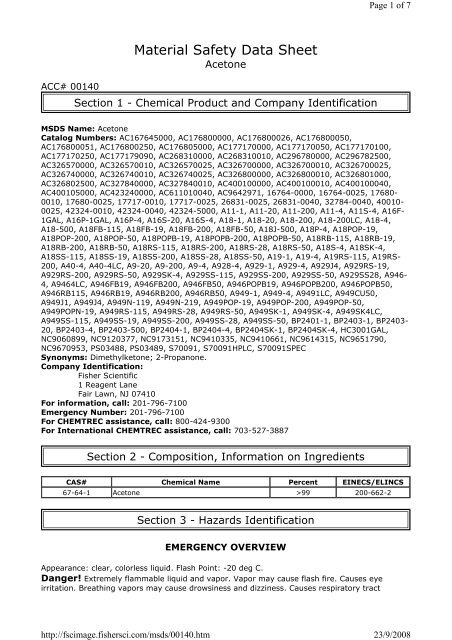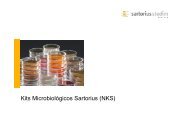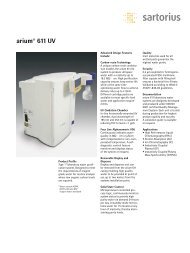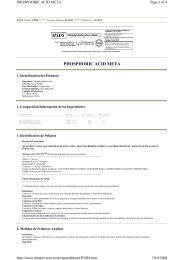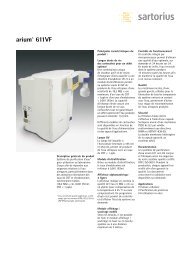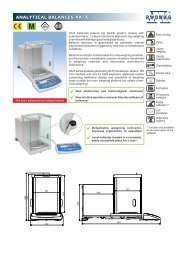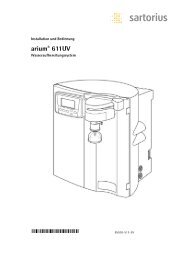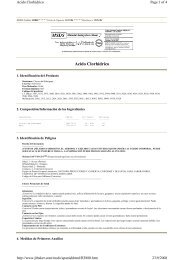Material Safety Data Sheet
Material Safety Data Sheet
Material Safety Data Sheet
You also want an ePaper? Increase the reach of your titles
YUMPU automatically turns print PDFs into web optimized ePapers that Google loves.
http://fscimage.fishersci.com/msds/00140.htmPage 1 of 723/9/2008ACC# 00140<strong>Material</strong> <strong>Safety</strong> <strong>Data</strong> <strong>Sheet</strong>AcetoneSection 1 - Chemical Product and Company IdentificationMSDS Name: AcetoneCatalog Numbers: AC167645000, AC176800000, AC176800026, AC176800050,AC176800051, AC176800250, AC176805000, AC177170000, AC177170050, AC177170100,AC177170250, AC177179090, AC268310000, AC268310010, AC296780000, AC296782500,AC326570000, AC326570010, AC326570025, AC326700000, AC326700010, AC326700025,AC326740000, AC326740010, AC326740025, AC326800000, AC326800010, AC326801000,AC326802500, AC327840000, AC327840010, AC400100000, AC400100010, AC400100040,AC400105000, AC423240000, AC611010040, AC9642971, 16764-0000, 16764-0025, 17680-0010, 17680-0025, 17717-0010, 17717-0025, 26831-0025, 26831-0040, 32784-0040, 40010-0025, 42324-0010, 42324-0040, 42324-5000, A11-1, A11-20, A11-200, A11-4, A11S-4, A16F-1GAL, A16P-1GAL, A16P-4, A16S-20, A16S-4, A18-1, A18-20, A18-200, A18-200LC, A18-4,A18-500, A18FB-115, A18FB-19, A18FB-200, A18FB-50, A18J-500, A18P-4, A18POP-19,A18POP-200, A18POP-50, A18POPB-19, A18POPB-200, A18POPB-50, A18RB-115, A18RB-19,A18RB-200, A18RB-50, A18RS-115, A18RS-200, A18RS-28, A18RS-50, A18S-4, A18SK-4,A18SS-115, A18SS-19, A18SS-200, A18SS-28, A18SS-50, A19-1, A19-4, A19RS-115, A19RS-200, A40-4, A40-4LC, A9-20, A9-200, A9-4, A928-4, A929-1, A929-4, A929J4, A929RS-19,A929RS-200, A929RS-50, A929SK-4, A929SS-115, A929SS-200, A929SS-50, A929SS28, A946-4, A9464LC, A946FB19, A946FB200, A946FB50, A946POPB19, A946POPB200, A946POPB50,A946RB115, A946RB19, A946RB200, A946RB50, A949-1, A949-4, A9491LC, A949CU50,A949J1, A949J4, A949N-119, A949N-219, A949POP-19, A949POP-200, A949POP-50,A949POPN-19, A949RS-115, A949RS-28, A949RS-50, A949SK-1, A949SK-4, A949SK4LC,A949SS-115, A949SS-19, A949SS-200, A949SS-28, A949SS-50, BP2401-1, BP2403-1, BP2403-20, BP2403-4, BP2403-500, BP2404-1, BP2404-4, BP2404SK-1, BP2404SK-4, HC3001GAL,NC9060899, NC9120377, NC9173151, NC9410335, NC9410661, NC9614315, NC9651790,NC9670953, PS03488, PS03489, S70091, S70091HPLC, S70091SPECSynonyms: Dimethylketone; 2-Propanone.Company Identification:Fisher Scientific1 Reagent LaneFair Lawn, NJ 07410For information, call: 201-796-7100Emergency Number: 201-796-7100For CHEMTREC assistance, call: 800-424-9300For International CHEMTREC assistance, call: 703-527-3887Section 2 - Composition, Information on IngredientsCAS# Chemical Name Percent EINECS/ELINCS67-64-1 Acetone >99 200-662-2Section 3 - Hazards IdentificationEMERGENCY OVERVIEWAppearance: clear, colorless liquid. Flash Point: -20 deg C.Danger! Extremely flammable liquid and vapor. Vapor may cause flash fire. Causes eyeirritation. Breathing vapors may cause drowsiness and dizziness. Causes respiratory tract
http://fscimage.fishersci.com/msds/00140.htmPage 2 of 723/9/2008irritation. Aspiration hazard if swallowed. Can enter lungs and cause damage. Prolonged orrepeated contact may dry the skin and cause irritation.Target Organs: Central nervous system, respiratory system, eyes, skin.Potential Health EffectsEye: Produces irritation, characterized by a burning sensation, redness, tearing, inflammation,and possible corneal injury. Vapors cause eye irritation.Skin: May be absorbed through the skin. Repeated or prolonged exposure may cause drying andcracking of the skin.Ingestion: May cause irritation of the digestive tract. May cause central nervous systemdepression, characterized by excitement, followed by headache, dizziness, drowsiness, andnausea. Advanced stages may cause collapse, unconsciousness, coma and possible death due torespiratory failure. Aspiration of material into the lungs may cause chemical pneumonitis, whichmay be fatal.Inhalation: Inhalation of high concentrations may cause central nervous system effectscharacterized by nausea, headache, dizziness, unconsciousness and coma. Causes respiratorytract irritation. May cause motor incoordination and speech abnormalities.Chronic: Prolonged or repeated skin contact may cause dermatitis. Chronic inhalation maycause effects similar to those of acute inhalation. Matsushita et al. exposed human volunteers 6hours/day for 6 days at 500 ppm acetone and found hematologic changes including significantlyincreased leukocyte and eosinophil counts and decreased neutrophil phagocytic activity.Section 4 - First Aid MeasuresEyes: In case of contact, immediately flush eyes with plenty of water for a t least 15 minutes.Get medical aid.Skin: In case of contact, flush skin with plenty of water. Remove contaminated clothing andshoes. Get medical aid if irritation develops and persists. Wash clothing before reuse.Ingestion: Potential for aspiration if swallowed. Get medical aid immediately. Do not inducevomiting unless directed to do so by medical personnel. Never give anything by mouth to anunconscious person. If vomiting occurs naturally, have victim lean forward.Inhalation: If inhaled, remove to fresh air. If not breathing, give artificial respiration. Ifbreathing is difficult, give oxygen. Get medical aid.Notes to Physician: Treat symptomatically and supportively.Section 5 - Fire Fighting MeasuresGeneral Information: If inhaled, remove to fresh air. If not breathing, give artificialrespiration. If breathing is difficult, give oxygen. Get medical aid. As in any fire, wear a selfcontainedbreathing apparatus in pressure-demand, MSHA/NIOSH (approved or equivalent), andfull protective gear. During a fire, irritating and highly toxic gases may be generated by thermaldecomposition or combustion. Use water spray to keep fire-exposed containers cool. Extremelyflammable liquid and vapor. Vapor may cause flash fire. Vapors are heavier than air and maytravel to a source of ignition and flash back. Vapors can spread along the ground and collect inlow or confined areas.Extinguishing Media: Use dry chemical, carbon dioxide, or appropriate foam. Water may beineffective because it will not cool material below its flash point.Flash Point: -20 deg C ( -4.00 deg F)Autoignition Temperature: 465 deg C ( 869.00 deg F)Explosion Limits, Lower:2.5%Upper: 12.8%NFPA Rating: (estimated) Health: 1; Flammability: 3; Instability: 0
http://fscimage.fishersci.com/msds/00140.htmPage 3 of 723/9/2008Section 6 - Accidental Release MeasuresGeneral Information: Use proper personal protective equipment as indicated in Section 8.Spills/Leaks: Absorb spill with inert material (e.g. vermiculite, sand or earth), then place insuitable container. Avoid runoff into storm sewers and ditches which lead to waterways. Wearappropriate protective clothing to minimize contact with skin. Remove all sources of ignition.Provide ventilation. A vapor suppressing foam may be used to reduce vapors. Water spray mayreduce vapor but may not prevent ignition in closed spaces. Use only non-sparking tools andequipment.Section 7 - Handling and StorageHandling: Wash thoroughly after handling. Remove contaminated clothing and wash beforereuse. Ground and bond containers when transferring material. Avoid contact with eyes, skin,and clothing. Empty containers retain product residue, (liquid and/or vapor), and can bedangerous. Keep container tightly closed. Do not pressurize, cut, weld, braze, solder, drill, grind,or expose empty containers to heat, sparks or open flames. Use only with adequate ventilation.Keep away from heat, sparks and flame. Avoid breathing vapor.Storage: Keep away from sources of ignition. Store in a tightly closed container. Store in a cool,dry, well-ventilated area away from incompatible substances. Flammables-area.Section 8 - Exposure Controls, Personal ProtectionEngineering Controls: Facilities storing or utilizing this material should be equipped with aneyewash facility and a safety shower. Use adequate general or local exhaust ventilation to keepairborne concentrations below the permissible exposure limits. Ventilation fans and otherelectrical service must be non-sparking and have an explosion-proof design.Exposure LimitsChemical Name ACGIH NIOSH OSHA - Final PELsAcetone500 ppm TWA; 750 ppmSTEL250 ppm TWA; 590mg/m3 TWA 2500 ppmIDLH (10% LEL)1000 ppm TWA; 2400mg/m3 TWAOSHA Vacated PELs: Acetone: 750 ppm TWA; 1800 mg/m3 TWAPersonal Protective EquipmentEyes: Wear chemical splash goggles.Skin: Wear butyl rubber gloves, apron, and/or clothing.Clothing: Wear appropriate protective clothing to prevent skin exposure.Respirators: A NIOSH/MSHA approved or European Standard EN 149 air purifying respiratorwith an organic vapor cartridge or canister may be permissible under certain circumstanceswhere airborne concentrations are expected.Section 9 - Physical and Chemical PropertiesPhysical State: LiquidAppearance: clear, colorlessOdor: sweetish odorpH: 7Vapor Pressure: 231 mm Hg @ 25 deg CVapor Density: 2.0 (Air=1)
http://fscimage.fishersci.com/msds/00140.htmPage 4 of 723/9/2008Evaporation Rate:5.6 (n-Butyl acetate=1)Viscosity: 0.32 cps @ 20 deg CBoiling Point: 56.5 deg CFreezing/Melting Point:-94 deg CDecomposition Temperature:Not available.Solubility: Soluble.Specific Gravity/Density:0.788 @ 25°CMolecular Formula:C3H6OMolecular Weight:58.08Section 10 - Stability and ReactivityChemical Stability: Stable at room temperature in closed containers under normal storage andhandling conditions.Conditions to Avoid: High temperatures, ignition sources, confined spaces.Incompatibilities with Other <strong>Material</strong>s: Strong oxidizing agents, strong reducing agents,strong bases, nitric acid, hexachloromelamine, sulfur dichloride, potassium tert-butoxide.Hazardous Decomposition Products: Carbon monoxide, carbon dioxide.Hazardous Polymerization: Will not occur.Section 11 - Toxicological InformationRTECS#:CAS# 67-64-1: AL3150000LD50/LC50:CAS# 67-64-1:Dermal, guinea pig: LD50 = >9400 uL/kg;Draize test, rabbit, eye: 20 mg Severe;Draize test, rabbit, eye: 20 mg/24H Moderate;Draize test, rabbit, eye: 10 uL Mild;Draize test, rabbit, skin: 500 mg/24H Mild;Inhalation, mouse: LC50 = 44 gm/m3/4H;Inhalation, rat: LC50 = 50100 mg/m3/8H;Oral, mouse: LD50 = 3 gm/kg;Oral, rabbit: LD50 = 5340 mg/kg;Oral, rat: LD50 = 5800 mg/kg;.Carcinogenicity:CAS# 67-64-1: Not listed by ACGIH, IARC, NTP, or CA Prop 65.Epidemiology: In a series of studies, no statistically significant differences in causes of death orclinical laboratory results were observed in 948 employees exposed to up to 1070 ppm acetoneover 23 years.Teratogenicity: Animal studies have only shown harmful effects in the offspring of animalsexposed to doses which also produced significant maternal toxicity.Reproductive Effects: During the Stewart et al. study, four adult female volunteers wereexposed 7.5 hours to acetone vapor at a nominal concentration of 1000 ppm.Three of the fourwomen experienced premature menstrual periods which were attributed to the acetoneexposure.Mutagenicity: Sex chromosome loss and nondisjunction(Yeast - Saccharomyces cerevisiae) =47600 ppm; Cytogenetic analysis(Rodent - hamster Fibroblast)= 40 gm/L.Neurotoxicity: No information foundOther Studies:
http://fscimage.fishersci.com/msds/00140.htmPage 5 of 723/9/2008Section 12 - Ecological InformationEcotoxicity: Fish: Rainbow trout: 5540 mg/l; 96-hr; LC50Fish: Bluegill/Sunfish: 8300 mg/l; 96-hr; LC50 No data available.Environmental: Volatilizes, leeches, and biodegrades when released to soil. TERRESTRIALFATE: If released on soil, acetone will both volatilize and leach into the ground. Acetone readilybiodegrades and there is evidence suggesting that it biodegrades fairly rapidly in soils. AQUATICFATE: If released into water, acetone will probably biodegrade. It is readily biodegradable inscreening tests, although data from natural water are lacking. It will also be lost due tovolatilization (estimated half-life 20 hr from a model river). Adsorption to sediment should notbe significant.Physical: ATMOSPHERIC FATE: In the atmosphere, acetone will be lost by photolysis andreaction with photochemically produced hydroxyl radicals. Half-life estimates from thesecombined processes are 79 and 13 days in January and June, respectively, for an overall annualaverage of 22 days. Therefore considerable dispersion should occur. Being miscible in water,wash out by rain should be an important removal process. This process has been confirmedaround Lake Shinsei-ko in Japan. There acetone was found in the air and rain as well as thelake.Other: No information available.Section 13 - Disposal ConsiderationsChemical waste generators must determine whether a discarded chemical is classified as ahazardous waste. US EPA guidelines for the classification determination are listed in 40 CFRParts 261.3. Additionally, waste generators must consult state and local hazardous wasteregulations to ensure complete and accurate classification.RCRA P-Series: None listed.RCRA U-Series:CAS# 67-64-1: waste number U002 (Ignitable waste).Section 14 - Transport InformationUS DOTCanada TDGShipping Name: ACETONE ACETONEHazard Class: 3 3UN Number: UN1090 UN1090Packing Group: II IISection 15 - Regulatory InformationUS FEDERALTSCACAS# 67-64-1 is listed on the TSCA inventory.Health & <strong>Safety</strong> Reporting ListNone of the chemicals are on the Health & <strong>Safety</strong> Reporting List.Chemical Test RulesCAS# 67-64-1: 40 CFR 799.5000Section 12bNone of the chemicals are listed under TSCA Section 12b.TSCA Significant New Use RuleNone of the chemicals in this material have a SNUR under TSCA.
http://fscimage.fishersci.com/msds/00140.htmPage 6 of 723/9/2008CERCLA Hazardous Substances and corresponding RQsCAS# 67-64-1: 5000 lb final RQ; 2270 kg final RQSARA Section 302 Extremely Hazardous SubstancesNone of the chemicals in this product have a TPQ.SARA CodesCAS # 67-64-1: immediate, fire.Section 313 No chemicals are reportable under Section 313.Clean Air Act:This material does not contain any hazardous air pollutants.This material does not contain any Class 1 Ozone depletors.This material does not contain any Class 2 Ozone depletors.Clean Water Act:None of the chemicals in this product are listed as Hazardous Substances under the CWA.None of the chemicals in this product are listed as Priority Pollutants under the CWA.None of the chemicals in this product are listed as Toxic Pollutants under the CWA.OSHA:None of the chemicals in this product are considered highly hazardous by OSHA.STATECAS# 67-64-1 can be found on the following state right to know lists: California, New Jersey,Pennsylvania, Minnesota, Massachusetts.California Prop 65California No Significant Risk Level: None of the chemicals in this product are listed.European/International RegulationsEuropean Labeling in Accordance with EC DirectivesHazard Symbols:XI FRisk Phrases:R 11 Highly flammable.R 36 Irritating to eyes.R 66 Repeated exposure may cause skin dryness or cracking.R 67 Vapours may cause drowsiness and dizziness.<strong>Safety</strong> Phrases:S 16 Keep away from sources of ignition - No smoking.S 26 In case of contact with eyes, rinse immediately with plenty ofwater and seek medical advice.S 9 Keep container in a well-ventilated place.WGK (Water Danger/Protection)CAS# 67-64-1: 0Canada - DSL/NDSLCAS# 67-64-1 is listed on Canada's DSL List.Canada - WHMISThis product has a WHMIS classification of B2, D2B.This product has been classified in accordance with the hazard criteria of the Controlled ProductsRegulations and the MSDS contains all of the information required by those regulations.Canadian Ingredient Disclosure ListCAS# 67-64-1 is listed on the Canadian Ingredient Disclosure List.Section 16 - Additional InformationMSDS Creation Date: 7/26/1999Revision #22 Date: 2/28/2008The information above is believed to be accurate and represents the best information currently available to us. However, wemake no warranty of merchantability or any other warranty, express or implied, with respect to such information, and we
http://fscimage.fishersci.com/msds/00140.htmPage 7 of 723/9/2008assume no liability resulting from its use. Users should make their own investigations to determine the suitability of theinformation for their particular purposes. In no event shall Fisher be liable for any claims, losses, or damages of any third partyor for lost profits or any special, indirect, incidental, consequential or exemplary damages, howsoever arising, even if Fisher hasbeen advised of the possibility of such damages.


